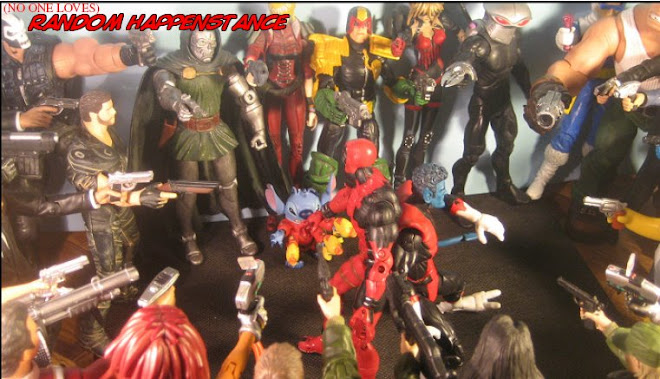
It's a little bit funny: I first saw the ads for the Steel Claw in Quality/Fleetway Judge Dredd reprints, around 1986 or so. While I was interested, I never saw the book, until a visit to a comic shop in Vegas when I got married, in 2003. And if I had given it any thought at all, I would've surmised those stories were reprints from 2000 AD, when in fact they were even older. Wikipedia had the breakdown of the Claw's publishing history, which was far more extensive than I would have thought. I was also surprised at the notion of the Steel Claw's international appeal; since I had only heard of it once, I had no idea. I also didn't know he appeared in the Alan Moore plotted Albion. Huh.
There is a good hook to it, as it were: Lab assistant Lewis Randell (Louis Crandell in the originals) has an artificial hand, the titular Steel Claw, as the result of a lab accident. This alone would be about four issues in modern comics, but it thankfully it's done by the first page here. Caught in another accident, Randell gains the power of invisibility, with two catches: he has to 'charge' the invisibility with an electrical shock, which doesn't affect him adversely; and the Claw itself remains visible. Although he doesn't seem all that stable before the accident either, Randell has what would be later charitably be called a psychotic break, and decides to use his newfound power for world domination. Pretty ambitious for a guy that's just mostly invisible.

Most of Randell's plans involve blackmail, such as him invisibly sabotaging stuff, then sending demands. Either because of the nature of his powers--Randell has to physically be there to cause the damage, then leave himself time to bail out--or because the future direction of the strip was already known, most of the trouble he causes doesn't do a lot of harm: usually, a quick-witted person at the scene puts the brakes on before anyone gets hurt. It builds up to the nuclear blackmail of New York City, and the army in place to try and stop the Claw from escaping before it blows.
Since he's the villain, Randell shouldn't be a heroic figure, especially since he's a bit of a loon for this sequence. But you can see why the Steel Claw became so popular: it's a straightforward adventure strip, immediate and exciting. The Claw's powers give out at the worst times, and it's a chess match between him and his old boss with a literal bomb ticking in the background.
After a brief coda with the mob trying to recruit the Claw, Randell is cured of his criminal insanity. He tries to return to a normal life, only to be framed by a mad scientist who had turned himself into a Mr. Hyde-style apeman. And painted his hand silver. Look, at the time, it probably wasn't much of a leap in logic to think maybe the guy that used to turn invisible might've mutated or something; and the authorities would doubtless have said guy that also threatened to blow up New York high on their list of suspects for anything.
By the fourth reprint issue, Randell is a secret agent, though investigator might be a better term--even invisible, "former nuclear blackmailer" is going to give him a higher Q rating than James Bond or Nick Fury put together. He's a superhero without a costume, though I understand he'd eventually end up with one; and the Claw itself can now be operated by remote control. Somehow. "Remote control" could probably have been replaced with "psychic link" without damaging any credibility there.
The Steel Claw's overseas popularity reminds me of another personal favorite, the Go Nagai giant robot cartoon Grandizer, which was Grendizer in the original, and known in various countries as Goldorak and Goldrake. It's barely a footnote here, yet it was quite successful elsewhere in the world. And both seem ripe for an update: both series were entertaining, remembered fondly, yet without the baggage of years of continuity and minutiae-obsessed fans. While it might be a little effects-heavy, I could absolutely picture a successful Steel Claw TV show. You could get a season or two alone out of his villainous days, and I like and identify a bit with the framing sequences' portrayal of Randell as an older gentleman a bit embarrassed by the excesses of his youth.
Of course, like Steve Austin, Ashley Williams, and Luke Skywalker, the Steel Claw is another fictional amputee with a prosthesis that seemed way better than the original hand. Even with all the medical advances since, it still doesn't work like that. Disappointing, that. Reprinted in the Steel Claw #1, script by H. Ken Bulmer, art by Jesus Blasco.

I have to admit, I don't get this at all. I mean, you can see his hand, sooo...
ReplyDeleteI mean, if I'm guarding a nuclear missile silo or something and I see a floating claw trying to break in, I'm still going to do something about it.
I remember reading it in the 70's. As a 7 year old you didn't question the extreme story lines just looked forward to next weeks installment.
ReplyDelete